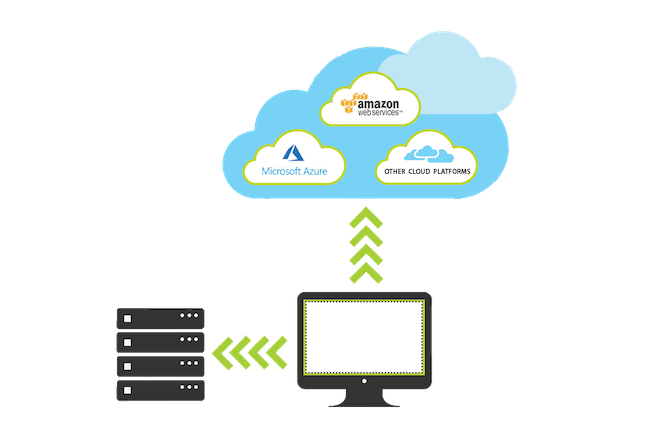

It’s a hybrid cloud/multi-cloud world: Why intelligent file transfer matters now more than ever.
 By Rick Clarkson, Chief Strategy Officer, Signiant
By Rick Clarkson, Chief Strategy Officer, Signiant
Over the past few years, IT managers in the M&E sector have been dealing with increasingly global and elaborate media supply chains. Consumer demand for content on any device, at anytime, anywhere in the world has pushed content production and distribution workflows to include far more people and far more file movement. On top of that, a massive surge of data in the industry — from increasing frame sizes and resolution rates, the adoption of virtual/augmented reality, and the massive amounts of raw footage capture required for reality-based programming, sports events and feature films — has further complicated the situation. New technologies, particularly innovations in cloud services, have emerged to help, but they can add even more complexity without the right plan.
Almost all media companies are adopting the cloud for some workflows and use cases, but most are not going all in. Rather, they’re choosing a ‘hybrid cloud’ approach, continuing to leverage on-premises storage and software alongside cloud investments. At the same time, many of those companies utilize multiple cloud vendors. This new hybrid cloud/multi-cloud world has a lot of benefits but also creates challenges, particularly around storage — which, in media, is always at the forefront of IT’s mind.
Managing storage is a difficult, ever-changing job
Not only do IT managers have to keep up with evolving storage options, they have to understand how each will interact with their entire software stack and determine if they will support both short and long-term business goals. The result often includes an array of tiered storage types that are distributed across multiple on- premises locations (private clouds) as well as across multiple public cloud providers and regions.
Often, the larger the company the more complex the situation, and even more so for companies that have been through mergers and acquisitions. In those situations, IT managers can face storage and software incompatibilities along with different legacy, active and potential storage solutions from dozens of vendors.
Whatever the situation, managing storage in today’s media environment is a difficult, ever-changing, job.
Signiant is well known in M&E for providing secure and reliable intelligent file transfer solutions. A unique aspect of Signiant’s platform is what we call storage independence, meaning our products are never bundled with storage and are compatible with all storage types, both on-premises and in the cloud. As a result, Signiant’s software provides a valuable abstraction layer, removing the complexity of dealing with different storage types in different locations. This empowers IT managers and end users in several ways.
Why storage independence matters
Many software vendors require customers to use a particular type of storage by bundling their services with storage (often their own) or only supporting a limited number of storage options. For example, services like Dropbox or Google Drive bundle storage as part of the service. Those services are great for many applications but have well-known limitations when working with large files, and storage bundling presents additional challenges with respect to security, cost and performance.
Arguably, for some types of software, storage independence doesn’t matter that much. However, in media, it’s critical. Most media companies understand the need for secure file acceleration solutions that can transfer large data volumes quickly over public and private IP networks. Storage independence, on the other hand, is a more recently recognized requirement, and is quickly becoming core to business operations for forward-thinking companies in M&E. Why?
At best, a lack of storage independence limits your ability to create a flexible storage strategy for all of your company’s assets and projects. At worst, it takes content out of your direct control and hides storage costs. It’s important that the software responsible for transferring files between your entire network of storage, systems, partners and people is flexible enough to support your storage choices, now and as the storage landscape continues to evolve.

Signiant’s SaaS and on-premises file acceleration solutions are storage independent and work seamlessly with both on-premises storage and multiple cloud storage vendors.
Hybrid cloud/multi-cloud file transfer use cases
In recent years, cloud storage has gained traction as organizations see the benefits of its elastic capabilities, raising new questions about what should stay on premises and how cloud storage should be leveraged. Most media companies have invested heavily in their fixed IT infrastructure, including on-premises tiered storage that balances performance and cost for different use cases. In those cases, it’s important to look for file acceleration software that can be deployed with and easily configured to support different storage types, whether on-premises or cloud. This allows IT managers to strategize on a case-by-case basis and as requirements change.
Here are three cases to consider:
1. Freeing up overflowing primary storage
A top concern for many media companies is freeing up local primary storage, which is typically housed in expensive, high-performing systems. Some companies choose to offload inactive content to mid-tier, more affordable on-premises systems, while others are offloading to cloud storage in AWS, Azure and/or Google in order to take advantage of its flexibility, ease of deployment, and pay-for-what- you-use pricing model.
2. Disaster recovery
Disaster recovery (DR) is one area where cloud storage is being adopted, offering elasticity and high availability. Short-term backup is typically put in place to facilitate disaster recovery for high-value projects such as feature films or episodic television production. Being able to quickly move large files to and from backup storage is required for disaster recovery. Acceleration software that overcomes network latency and congestion typically associated with moving large data sets to or from cloud storage is key for DR. In these cases, having a file transfer solution that both moves large files quickly and supports storage independence allows you to choose and switch between cloud storage providers, supporting an intelligent, flexible storage strategy.
3. Long-term archiving
Archiving is another area where cloud storage is being considered now that lower cost options are available such as AWS Glacier. Glacier offers a much lower cost tier of storage but sacrifices the immediacy required for DR. However, it still is important to be able to move your files quickly into archives as the amount of content produced in a day may exceed the amount of available network bandwidth you have to move it at night. Acceleration software allows companies to get their data into backup storage during off hours to keep the network freed up when creative resources are at work.
Growing importance of intelligent file transfer solutions
In the end, companies should assume the volume of content will continue to grow as will storage options. As new features or new providers become appropriate to implement, there should be no barriers to adoption. This is where large file transfer solutions that are fully storage independent grow in importance.
Storage independence has long been a central tenant in the design of all of Signiant’s intelligent file transfer solutions. Our products allow the flexibility to choose the right storage for each situation, never tying you to any one storage type or vendor, whether on-premises or cloud. For media companies already in the hybrid cloud/multi-cloud world, Signiant technology has become an increasingly important abstraction layer, allowing IT to choose different storage types for different use cases while giving creative professionals and partners a secure means to transfer content with speed and ease.
And for media companies planning to adopt a hybrid cloud/multi-cloud approach now or in the future, intelligent large file transfer solutions that are storage independent will be essential to thriving in that new world.
About Signiant
Signiant’s enterprise software provides the world’s top content creators and distributors with fast, reliable, secure access to large media files, regardless of physical storage type or location. By enabling authorized people and processes to seamlessly exchange valuable content – within and between enterprises – Signiant connects the global media supply chain. For more information, please visit www.signiant.com.
Tags: Technology




Comments